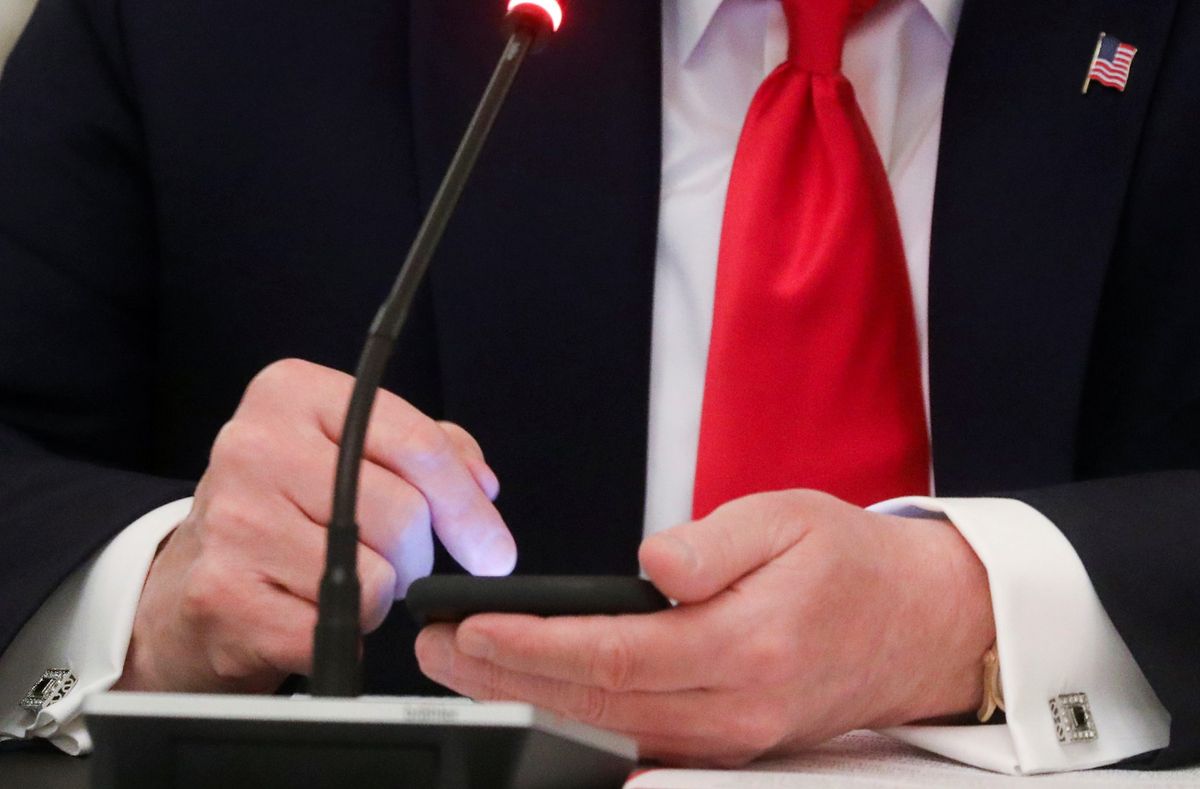The Twitter presidency: President Trump’s most impactful tweets

A few minutes every morning is all you need.
Stay up to date on the world's Headlines and Human Stories. It's fun, it's factual, it's fluff-free.
At the end of Trump’s Twitter presidency, it’s worth looking back on some of the most consequential missives sent from @realDonaldTrump.
Journalists, politicos and historians will be analyzing the impact and influence of President Donald Trump for decades. His unprecedented presidency, ushered in by public distrust in major institutions and a wave of disinformation, was the linchpin of an era of nearly unparalleled political division and rancor.
Quite frequently, at the center of that political maelstrom was Trump’s personal Twitter account.
Like few other politicians, Trump utilized the power of social media to communicate his intentions, rally his supporters and infuriate his detractors. While Trump also used Facebook and Instagram, and there is an official @POTUS account, Trump’s most reliable means of communication during his four-year term as president was his @realDonaldTrump Twitter account.
From that account, Trump announced policy, attacked critics and enemies, praised allies, endorsed political candidates and, especially during and after the election, shared misinformation. Since President Barack Obama’s first term, Trump has used his account to spread lies and conspiracy theories. Being president didn’t temper those habits. Instead, it has only amplified the falsehoods.
Trump’s relationship with the social media platform has been contentious at times, with Twitter fact-checking his tweets and the president accusing the platform of “stifling free speech.” Nonetheless, Trump remains a steadfast user of Twitter (even with the existence of the conservative-friendly Parler), on occasion tweeting or retweeting accounts hundreds of times a day.
At the end of Trump’s Twitter presidency, it’s worth looking back on some of the most consequential missives sent from @realDonaldTrump.
Trump announces policy
Leading up to Trump’s victory in the 2016 election, the real estate mogul and reality television host had been a voracious user of Twitter. He used it to criticize President Barack Obama, to advertise his Trump-branded properties and even to trade in celebrity gossip. Yet, before the election, Trump stated he would give up his Twitter account if he won, saying it was “not presidential.”
That clearly didn’t happen. Though Trump’s Twitter activity after winning the election did decline for a time, it has steadily gone up through his term. It didn’t take long into Trump’s presidency for it to become clear his personal Twitter account was going to play a substantial role.
On July 26, 2017, Trump announced a major policy change via three unthreaded (i.e., unconnected) tweets: “The United States Government will not accept or allow Transgender individuals to serve in any capacity in the U.S. Military.” The tweets went on to explain the reasoning was the “burden” caused by the “tremendous medical costs and disruption that transgender in the military would entail.”
Not only was this a reversal of an Obama-era policy that had officially lifted a ban on transgender service members, but it was the first major policy change announced via Twitter. It wouldn’t be the last time Trump’s Twitter feed signaled a policy change.
Foreign policy was frequently revealed or changed by tweet. For instance, when Trump announced the withdrawal of American troops from Syria, it was reported that the US’ Kurdish allies in the region learned of the withdrawal via Trump’s Twitter account.
Additionally, Trump’s propensity for insulting or complimenting adversarial foreign leaders via his account made for often muddled foreign policy. He even took shots at US allies, like French President Emmanuel Macron.
“You’re fired”
Having turned “You’re fired” into a catchphrase on his reality TV show, “The Apprentice,” it was probably inevitable that Trump would be an executive who was quick to let go of his government employees. What did take people by surprise was his propensity for dismissing top officials via Twitter.
In November 2020, Trump did it twice. On the 9th, Trump fired his former Defense Secretary Mark Esper via two tweets that also announced Esper’s replacement. A little over a week later, Trump fired Chris Krebs as the Director of the Cybersecurity and Infrastructure Security Agency after Krebs refused to support Trump’s claims that the election was stolen by the Democrats.
It is an ignominious way for such high-ranking government officials to be dismissed, but at least Esper and Krebs can take heart that they weren’t the first.
That dubious honor went to Trump’s first White House Chief of Staff, Reince Priebus, who left the position only six months into the presidential term. Across three unthreaded tweets on July 28, 2017, Trump announced Priebus’s replacement, General John Kelly (who would leave the position in late 2018), and thanked Priebus “for his service and dedication to his country.”
While it was reported that Priebus had tendered his resignation the day before Trump’s tweets, to the general population, it appeared Trump was firing his chief of staff on Twitter.
A few months later, Trump really did fire a top official via Twitter: former Secretary of State Rex Tillerson. As with the Priebus and Esper tweets, Tillerson’s departure was announced alongside the revelation of his replacement: Mike Pompeo. Unlike Priebus, Tillerson reportedly learned of his dismissal from the March 13, 2018 tweet.
Trump announces he has COVID-19
A Trump tweet is all but guaranteed to earn tens of thousands, if not hundreds of thousands of “likes” from Twitter users. Trump, who has 88 million followers on the platform (though many are likely bots and the numbers have been declining since he lost the election), also uses his account to boost other accounts, generally users who are expressing support for him.
Nonetheless, for a president who puts such a high value on strong ratings and popularity, his tweets never quite achieve the stratospheric response that tweets by both his predecessor and successor have achieved.
The Trump tweet that has received the most likes came on October 2 of this year, when the president announced he and his wife, Melania, had tested positive for COVID-19: “Tonight, @FLOTUS and I tested positive for COVID-19. We will begin our quarantine and recovery process immediately. We will get through this TOGETHER!”
That tweet currently has 1.8 million likes, by far his best-performing tweet. Though both he and Melania eventually recovered from the coronavirus, the replies to the tweet were by and large not supportive.
Critics saw Trump’s diagnosis as a fitting outcome to a lacking federal government response to the pandemic. Trump’s COVID-19 diagnosis came as the culmination of months of the president downplaying the severity of the virus, resisting the use of a mask, touting unproven cures and criticizing his own Coronavirus Task Force.
Typos and mistakes
Though typos and grammatical mistakes are just a part of the social media landscape, when those errors are made by the US president, they are rarely ignored. Often, when Trump misspelled something or used the wrong form of a word, the tweet was deleted shortly thereafter and rewritten with the appropriate corrections.
While typos have appeared in more noteworthy Trump tweets, no other mistake garnered more widespread attention – and mockery – than the famous “covfefe” tweet in the early morning of May 31, 2017: “Despite the constant negative press covfefe”. While the tweet is now deleted (though preserved at Factba.se), it lives on in memes, jokes and unfortunate puns.

Viral tweets explained how to pronounce the newly coined word, shoehorned it into pop culture references and substituted the word for “coffee” in hundreds of hacky jokes. Even Trump’s 2016 opponent, former Secretary of State Hillary Clinton, got in on the fun.
Trump, who generally does not acknowledge his typographical mistakes, could not ignore the cultural impact of “covfefe.” Hours later, after the original tweet had been deleted, he tweeted, “Who can figure out the true meaning of ‘covfefe’ ??? Enjoy!” That tongue-in-cheek response was one of only a few times the president has seemingly poked fun at himself.
Citizen Trump
In less than a month, Trump will no longer be president, but he will surely continue to speak to his supporters and detractors via his Twitter account. Even if the rumors that he is looking to build his own media empire are true, it’s hard to imagine Trump giving up on his favorite medium for communicating his thoughts, beliefs and grievances.
However, one thing may change: Trump’s ability to tweet false information. While Twitter and other social media companies are actively seeking to remove conspiracy theory content and other forms of misinformation, Trump’s tweets have not been deleted, merely fact-checked. As a world leader, Twitter has argued, Trump’s tweets have value, even when they’re false.
That will no longer be the case once Trump is out of office and returns to civilian life. However, if Trump chooses to run for reelection in 2024, which is considered a high likelihood at this point, he may once again be afforded greater leniency on Twitter than other users.
Have a tip or story? Get in touch with our reporters at tips@themilsource.com




Comments ()